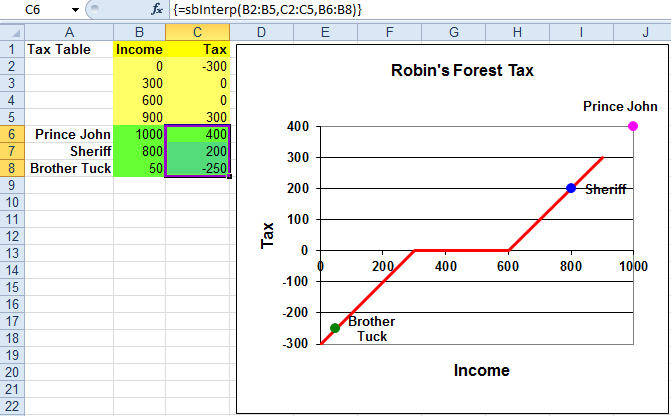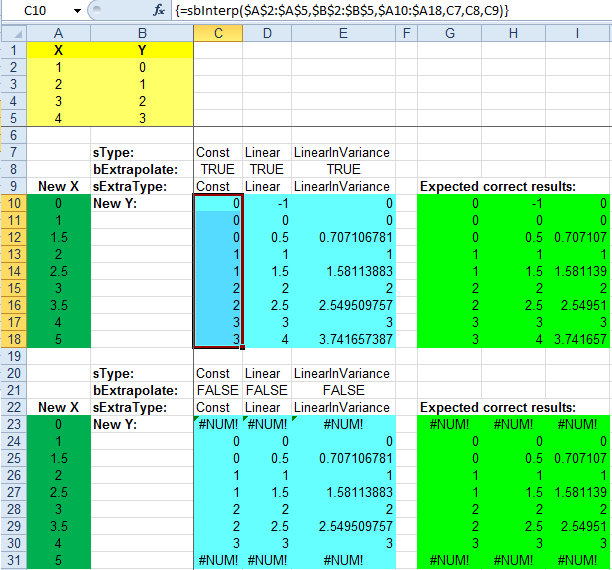“Write what you know. That should leave you with a lot of free time.” [Howard Nemerov]
Abstract
Falls Sie eine Menge von bekannten (x, y) Paaren haben und y-Werte zu anderen gegebenen x-Werten finden müssen, müssen Sie interpolieren. Dies entspricht dem Füllen von Lücken in einer Tabelle:


Appendix – Programmcode sbInterp
Bitte den Haftungsausschluss im Impressum beachten.
Option Explicit
Function sbInterp(vX As Variant, vY As Variant, _
vT As Variant, _
Optional ByVal sType As String = "Linear", _
Optional bExtrapolate As Boolean = True, _
Optional ByVal sExtraType As String) As Variant
'Interpolates y-values for target values vT with known
'y-values vY and known x-values vX with type sType.
'sType can be:
'Const or C
'Linear or L
'LinearInVariance or LIV
'Extrapolation will be done if bExtrapolate is TRUE.
'Extrapolation type sExtraType defaults to sType if empty.
'Values in vX must be in ascending order. #VALUE! error
'indicates illegal sType, #NUM! error indicates that
'extrapolation has been switched off and #N/A tells you
'that x-values are not given in increasing order, or
'y-value count differs from x-value count.
'Source (EN): https://www.sulprobil.de/sbinterp_en/
'Source (DE): https://www.berndplumhoff.de/sbinterp_de/
'(C) (P) by Bernd Plumhoff 25-Dec-2023 PB V0.7
Dim i As Long, iX As Long, iY As Long, iT As Long, k As Long
Dim vTk, vXi
Dim sT As String 'Type of inter- or extrapolation
Dim sEType As String 'Extrapolation type
With Application
On Error Resume Next
iX = vX.Count
iX = UBound(vX)
iY = vY.Count
iY = UBound(vY)
iT = vT.Count
iT = UBound(vT)
On Error GoTo 0
If iX <> iY Then
sbInterp = CVErr(xlErrNA)
Exit Function
End If
k = 0
ReDim vX1(1 To iX) As Variant, vY1(1 To iX) As Variant
For i = 1 To iX
If vX(i) <> "" And vY(i) <> "" Then
k = k + 1
vX1(k) = vX(i)
vY1(k) = vY(i)
End If
Next i
iX = k
ReDim Preserve vX1(1 To iX) As Variant
ReDim Preserve vY1(1 To iX) As Variant
If iX < 2 Then
sType = "Const"
sExtraType = "Const"
Else
For k = 2 To iX
If vX1(k) <= vX1(k - 1) Then
sbInterp = CVErr(xlErrNA)
Exit Function
End If
Next k
End If
ReDim vR(1 To iT) As Variant
If sExtraType = "" Then
sEType = sType 'Same as interpolation type
Else
sEType = sExtraType
End If
For k = 1 To iT
i = 0
vTk = 0
vXi = 0
On Error Resume Next
i = .Match(vT(k), vX1, 1)
vTk = vT(k)
vXi = vX1(i)
On Error GoTo 0
If Not bExtrapolate And _
(i = 0 Or (i = iX And vTk <> vXi)) Then
vR(k) = CVErr(xlErrNum)
Else
sT = sType 'Set to interpolation type
If i = 0 Then
i = 1
sT = sEType 'Set to extrapolation type
End If
If i = iX Then
i = i - 1
If vTk <> vXi Then
sT = sEType 'Set to extrapolation type
End If
If sT = "C" Or sT = "Const" Then i = i + 1
End If
Select Case sT
Case "C", "Const"
vR(k) = .Index(vY1, i)
Case "L", "Linear"
vR(k) = .Index(vY1, i) + (vTk - .Index(vX1, i)) _
* (.Index(vY1, i + 1) - .Index(vY1, i)) _
/ (.Index(vX1, i + 1) - .Index(vX1, i))
Case "LIV", "LinearInVariance"
On Error Resume Next
vR(k) = Sqr(.Index(vY1, i) ^ 2# + (vTk - .Index(vX1, i)) _
* (.Index(vY1, i + 1) ^ 2# - .Index(vY1, i) ^ 2#) _
/ (.Index(vX1, i + 1) - .Index(vX1, i)))
On Error GoTo 0
Case Else
sbInterp = CVErr(xlErrValue)
Exit Function
End Select
End If
Next k
If TypeName(vT) = "Range" Then
If vT.Rows.Count > vT.Columns.Count Then
vR = .Transpose(vR)
End If
ElseIf TypeName(.Caller) = "Range" Then
If .Caller.Rows.Count > .Caller.Columns.Count Then
vR = .Transpose(vR)
End If
End If
sbInterp = vR
End With
End Function
Download
Bitte den Haftungsausschluss im Impressum beachten.
sbinterp.xlsm [36 KB Excel Datei, ohne jegliche Gewährleistung]